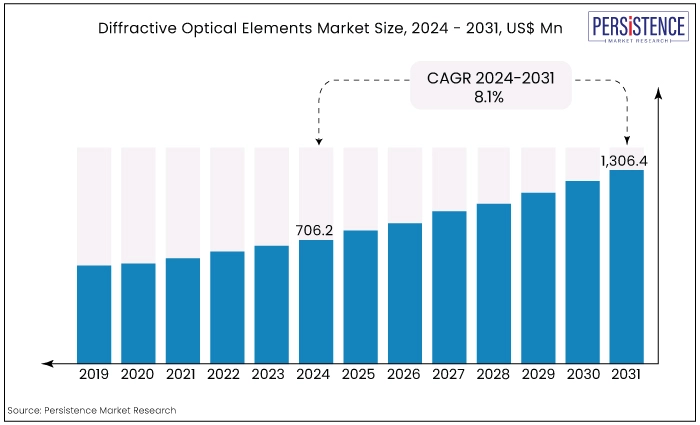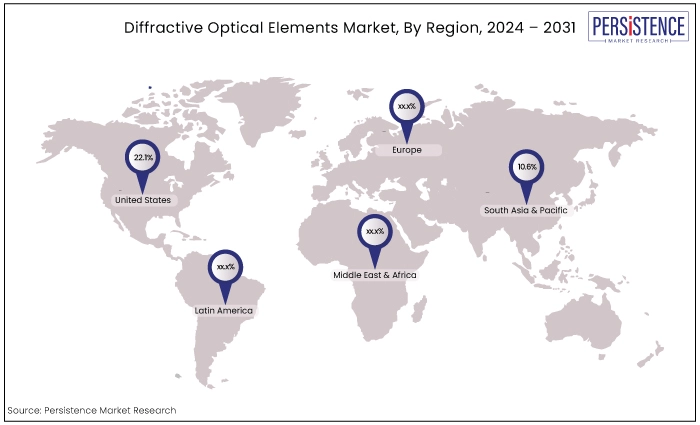Industry: Semiconductor Electronics
Published Date: July-2024
Format: PPT*, PDF, EXCEL
Delivery Timelines: Contact Sales
Number of Pages: 179
Report ID: PMRREP14389
The global diffractive optical elements market size that was worth around US$706.2 Mn in 2023 is expected to reach a valuation of US$1,306.4 Bn by the end of 2031. Between 2024 and 2031, the market revenue is likely to witness a CAGR of 8.1%.
Key Highlights of the Market
|
Attributes |
Key Insights |
|
Market Size (2023E) |
US$ 706.2 Mn |
|
Projected Market Value (2031F) |
US$ 1,306.4 Mn |
|
Forecast Growth Rate (CAGR 2024-2031) |
8.1% |
|
Historical Growth Rate (CAGR 2018-2023) |
7.6% |
Diffractive optical elements market accounts for the 25% share of the optics & photonics market. Diffractive optical elements (DOEs) are thin, micro-structured components that manipulate light by diffracting it into various directions or focusing it into specific patterns.
DOEs can be made from materials such as glass, plastic, or silicone, and they typically have a series of complex, microscopic patterns etched onto their surfaces using photolithography, electron beam writing, or other precision manufacturing techniques.
DOEs are commonly used in optical systems for a variety of applications, including beam shaping, beam splitting, and diffraction gratings. They can also be used in holography, laser optics, and other areas of optical research and technology.
Since they can be designed with great precision and offer a high degree of control over the properties of light, DOEs are an important tool for a range of scientific and engineering applications.
Increasing demand for advanced optical systems together with advancements in manufacturing technology are the major factors influencing the growth of the diffractive optical element market. There is a growing demand for optical systems with high precision and accuracy in a range of industries, including aerospace, defence, medical, and telecommunications.
DOEs can offer significant advantages over traditional refractive optics in terms of performance, compactness, and cost-effectiveness, driving demand for these products.
According to the geographical market estimates, the North American region will account for approximately 25% of the diffractive optical elements market size. Whereas, in Europe, consumption of these solutions is estimated to account for more than 22% of the total market.

The market experienced steady growth, primarily driven by advancements in telecommunications, digital displays, and automotive sectors. While there were notable strides in DOE technology, adoption was often restricted due to high production costs and design complexities. The market was primarily concentrated in developed economies.
The DOE market is anticipated to witness accelerated growth due to several converging factors. Advancements in nanofabrication, coupled with declining production costs, will broaden DOE applications.
Integration with AI, and AR will create new market segments. Expanding into emerging economies will unlock vast opportunities. The market is expected to diversify beyond traditional sectors, with increased penetration in healthcare, consumer electronics, and industrial automation. The industry holds promise to a more robust and dynamic DOE market.
Technological Advancements, and Performance Enhancements
The diffractive optical elements (DOEs) market is experiencing significant growth due to rapid advancements in optical design software and manufacturing techniques. These developments have led to improved DOE performance, expanded applications, and reduced production costs.
Optical design software has become increasingly sophisticated, enabling engineers to optimize DOE parameters with precision. This has resulted in the creation of DOEs with higher diffraction efficiency, reduced aberrations, and wider operating spectral ranges.
Additionally, advancements in nanofabrication techniques have allowed for DOE production with finer feature sizes and complex structures, enhancing their optical performance. These technological breakthroughs have expanded the range of potential applications for DOEs, driving the growth of the market.
Expanding Applications Across Industries
The versatility of DOEs has led to their adoption across a wide range of industries. One key growth driver is the increasing demand for compact and lightweight optical systems. DOEs offer a compact and efficient solution for beam shaping, focusing, and splitting, making them ideal for applications in consumer electronics, such as smartphones and augmented reality devices.
Furthermore, the automotive industry is experiencing rapid growth in the adoption of advanced driver assistance systems (ADAS), and autonomous vehicles.
DOEs play a critical role in LiDAR systems, which are essential for object detection and distance measurement. The increasing demand for ADAS and autonomous vehicles is driving the growth of the DOE market in this sector.
Additionally, the healthcare industry is utilizing DOEs for various applications, including optical microscopy, laser surgery, and dental imaging. The expanding application base for DOEs across different industries is a major factor driving the market ahead.
High Costs, Coupled with Limited Availability of High-Quality Materials
DOEs can be expensive to produce due to the precision required in their manufacturing. This can make them unaffordable for many potential customers, particularly those in developing countries.
DOEs are typically made from specialized materials, such as photoresists and plastics, which can be difficult to source in some regions. This can limit the production of high-quality DOEs.
Integration with AI
The convergence of diffractive optics and artificial intelligence presents a significant opportunity. AI algorithms can be employed to optimize DOE designs for specific applications, leading to enhanced performance and reduced development time.
Additionally, AI-powered systems can analyse large datasets of DOE performance data to identify new design patterns and materials. This integration can accelerate innovation and create new market opportunities.
Expansion in Developing Markets
Developing countries with rapidly growing economies and expanding industrial sectors offer substantial potential for the DOE market. These regions are experiencing increasing demand for advanced technologies, including those based on optics.
By focusing on cost-effective solutions and addressing specific regional needs, companies can capture a significant market share. Furthermore, collaborations with local research institutions and government bodies can facilitate market entry and technology transfer.
The Beam Splitters Segment Captures the Maximum Market Share
Beam splitters are one of the most popular types of diffractive optical elements (DOEs) and they hold a major market share in the DOE market for several reasons like versatility, high efficiency and so on.
The beam splitter market share was recorded to be around 51.3% in the year 2023. Beam splitters are versatile and can be used in a wide range of applications, such as beam shaping, laser interferometry, optical communication, and biomedical imaging.
Beam splitters are designed to split light into multiple beams with high efficiency. They can split light in a variety of ways, such as evenly splitting the light or splitting it in a specific ratio.
Biomedical Devices Represent the Leading Application Segment
The adoption of diffractive optical elements (DOEs) is particularly high for biomedical devices application due to the following reasons like miniaturization, high precision and so on.
Biomedical devices, such as endoscopes, catheters, and lab-on-a-chip systems, require compact and lightweight optical components that can be integrated into small form factor devices. DOEs are ideal for such applications as they are typically smaller and lighter than traditional refractive optics.
DOEs can achieve high precision in shaping and manipulating light. This precision is particularly important in biomedical applications, where accurate and precise control of light is critical for tasks such as imaging, sensing, and targeted therapy.
Thus, adoption of refractive optical element continues to be maximum in the biomedical devices application category, equalling 28.4% revenue share in the diffractive optical elements market in 2023.
US Witnessing Ascending Adoption as Demand from Aerospace & Defense Heightens
DOEs are used in a variety of applications in the aerospace and defence industries, such as beam shaping, beam splitting, and wave front correction. With the increasing demand for advanced optical systems in these industries, the adoption of DOEs is expected to continue to grow.
Additionally, DOEs are used in medical imaging systems for applications such as fluorescence microscopy, confocal microscopy, and optical coherence tomography. The increasing demand for high-resolution imaging in the medical industry is driving the adoption of DOEs.
These aspects are aiding the acceptance of these technologies in the United States region, accounting to the region's considerable market share of 22.1% in 2022.
Increasing Demand for Advanced Optical Systems Creates Potential Opportunities in Indian Markets
There is a growing demand for advanced optical systems in industries such as aerospace, defense, and telecommunications in India. DOEs can offer significant advantages over traditional refractive optics in terms of performance, compactness, and cost-effectiveness, driving demand for these products.
Additionally, holographic technology has a wide range of applications in India, including 3D imaging, data storage, and security. DOEs are an essential component of holographic systems, driving demand for these products.
The South Asia & Pacific region, prominent in this industry, is projected to see a solid CAGR of 10.6% by 2031-end. The India diffractive optical elements market anticipated a CAGR of 12.3% during the predicted period.
Germany Maintains a Substantial Market Share, Favorable Government Policies Facilitate Adoption
Germany has a strong R&D sector with a focus on high-tech industries, including optics and photonics. This has enabled German companies to develop advanced DOE technologies and innovative products, giving them a competitive advantage in the market.
Moreover, the German government has implemented policies that promote innovation and technological development, including in the optics and photonics industry. These policies have helped to support the growth of the diffractive optical elements market in Germany.
Such considerations are predicted to hasten the deployment of diffractive optical element services in Germany.

The market is highly fragmented, with several small and medium-sized companies operating in the market, in addition to the larger players. The key strategies adopted by these players include new product launches, collaborations, partnerships, and mergers and acquisitions to expand their market presence and improve their product offerings.
January 2023
HOLOEYE launched customized DOEs depending on your optical and mechanical demands. The development service covers all stages, including engineering & simulation, mastering & tooling, volume fabrication, quality testing as well as implementation assistance.
January 2023
Coherent Corp. had launched a product line of diffractive optical elements for high-power industrial lasers. Optical element advancement is essential to considerably decrease the cost of operation of commercial lasers & speeding their acceptance in both new & existing applications
February 2022
Researchers achieved multichannel information transmission in free space using variably polarised beams, according to a report published by the Multidisciplinary Digital Publishing Institute. The interplay of vortex beams of different orders with the main polarisation states is studied theoretically. The numerical simulation of the transit of beams with various polarisation states via multi-order diffractive optical elements is performed.
|
Attribute |
Details |
|
Forecast Period |
2024 to 2031 |
|
Historical Data Available for |
2018 to 2023 |
|
Market Analysis |
US$ Million for Value |
|
Key Regions Covered |
|
|
Key Countries Covered |
|
|
Key Market Segments Covered |
|
|
Key Companies Profiled |
|
|
Pricing |
Available upon Request |
By Type:
By Application:
By Industry:
By Region:
To know more about delivery timeline for this report Contact Sales

The market was worth around US$706.2 Mn in 2023.
The market has been projected to witness a CAGR of 8.1% during 2024-2031.
Beam splitters represent the dominant market segment by type, whereas the biomedical devices segment leads the market by application.
North America currently dominated the global market for diffractive optical elements.
Some of the key market players include Broadcom Inc., Jenoptik AG, Laserglow Technologies, SÜSS MICROTEC SE, and HOLO/OR LTD.